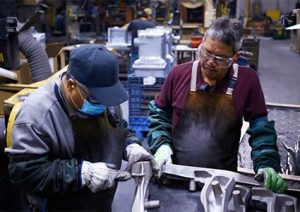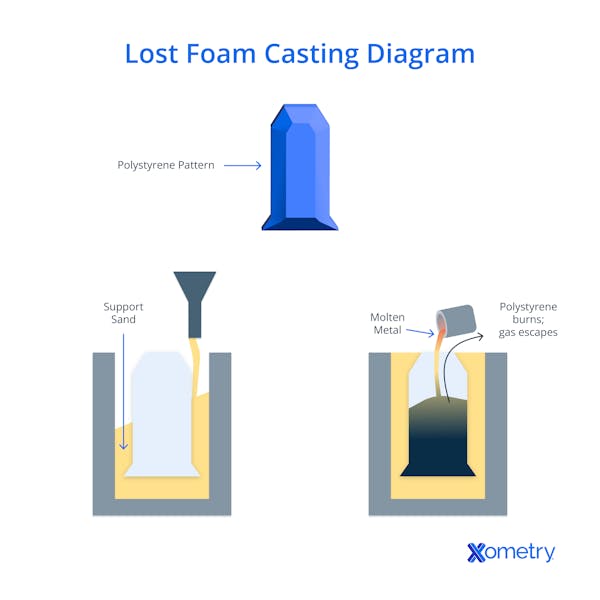When Aluminum Foundry Wisconsin enhances casting processes
Wiki Article
Exactly How Aluminum Foundry Adds To Advancements in Aerospace Engineering
Aluminum factories are important to improvements in aerospace engineering. They create light-weight, high-strength parts that are important for modern airplane. With advanced spreading methods, these foundries produce complex geometries that improve architectural honesty. In addition, the development of premium Aluminum alloys sustains the sector's concentrate on fuel effectiveness and sustainability. Difficulties stay in the manufacturing process. Recognizing these elements exposes the profound effect of Aluminum on aeronautics's future.The Importance of Lightweight Materials in Aerospace Style
As the aerospace sector proceeds to progress, the significance of light-weight materials ends up being significantly obvious. The demand for efficiency and sustainability drives engineers to focus on the use of products that lower total weight without endangering structural integrity. Light-weight materials, particularly Aluminum, play a vital function in enhancing fuel performance, enhancing payload capability, and enhancing the overall efficiency of aircraft.The combination of these materials permits for innovative designs, making it possible for manufacturers to create even more aerodynamic forms that can stand up to extreme problems. The decrease in weight not only decreases operational costs but likewise contributes to a lowered ecological footprint, lining up with global efforts toward sustainability in aviation.
Advanced Spreading Techniques in Aluminum Foundries
Advanced casting techniques in Aluminum factories play a crucial duty in aerospace design by allowing the manufacturing of lightweight and exact elements. Advancements in mold design and accuracy spreading procedures are important in accomplishing ideal performance and architectural honesty. Furthermore, the advancement of lightweight alloys improves the overall efficiency and efficiency of aerospace applications.Cutting-edge Mold And Mildew Design
Ingenious mold and mildew style plays an essential duty in the performance and effectiveness of Aluminum shops, particularly within the aerospace market. By leveraging advanced products and techniques, contemporary mold and mildews can be engineered to withstand high temperatures and stress, guaranteeing peak efficiency throughout the spreading process. These designs usually integrate intricate geometries that enable the production of light-weight yet structurally audio elements, crucial for aerospace applications. Furthermore, using computer-aided design (CAD) software program assists in accurate modeling, enabling foundries to refine and simulate mold designs prior to physical production starts. This not just enhances the top quality of actors components yet likewise minimizes waste and preparation, leading to significant expense financial savings. On the whole, innovative mold layout is a cornerstone of progress in Aluminum Foundry technology for aerospace engineering.Precision Casting Processes
The efficiency of cutting-edge mold designs perfectly incorporates with accuracy spreading procedures, which are important for producing high-grade Aluminum parts in aerospace design. These processes, including sand casting, pass away casting, and investment casting, assure the production of complex geometries with limited resistances. Advanced methods like vacuum cleaner spreading and stress die casting boost the stability and surface area coating of the end products. Precision spreading lessens product waste while making best use of the mechanical homes of Aluminum, crucial for aerospace applications. On top of that, employing real-time surveillance and progressed simulation tools during the casting process permits immediate changes, bring about enhanced quality assurance. Jointly, these accuracy spreading procedures placement Aluminum shops at the leading edge of aerospace technology, sustaining the sector's need for integrity and performance.Light-weight Alloy Growth
As aerospace engineers look for to boost fuel efficiency and efficiency, light-weight alloy development comes to be an important focus in Aluminum factories. These factories employ sophisticated casting strategies to create alloys that provide superior strength-to-weight ratios. Technologies in alloy make-up, consisting of the unification of elements like lithium and magnesium, make it possible for the manufacturing of products that endure severe problems while decreasing total airplane weight. Strategies such as die spreading and investment casting assist in the precision production of intricate shapes, which are vital for aerospace applications. Furthermore, recurring research aims to maximize these alloys for enhanced mechanical residential properties and raised durability. By prioritizing light-weight alloy development, Aluminum shops greatly add to the evolution of aerospace engineering, leading the way for much more sustainable and reliable aircraft layouts.
Enhancing Structural Integrity With Aluminum Parts
Aluminum elements provide significant advantages in improving architectural honesty within aerospace design. Their light-weight nature adds to total performance while maintaining toughness, which is necessary for airplane performance. In addition, the tension resistance buildings of Aluminum assistance ensure the longevity and integrity of aerospace structures under numerous operational problems.
Light-weight Product Benefits
While standard materials frequently jeopardize weight for stamina, using Aluminum components in aerospace engineering offers significant advantages in structural integrity. Aluminum's lightweight nature contributes to total style performance, enabling for more structured aircraft that take in less gas, thereby enhancing sustainability. The material's excellent strength-to-weight ratio warranties that elements preserve resilience without including unneeded mass. This high quality promotes improved efficiency and dexterity in flight, as well as enhanced payload capacities. Additionally, Aluminum's resistance to deterioration extends the life expectancy of aerospace frameworks, reducing upkeep costs and improving safety and security. As producers increasingly embrace Aluminum alloys, the aerospace sector experiences a transformative change towards a lot more effective and effective engineering options that focus on both performance and ecological responsibility.Anxiety Resistance Features
Various products have special residential properties, Aluminum's extraordinary tension resistance stands out as a vital variable in enhancing the structural stability of aerospace components. This resistance plays a critical role in guaranteeing that airplane can stand up to numerous functional anxieties, including fatigue, effect, and ecological conditions. Aluminum alloys, particularly engineered for aerospace applications, display high tensile stamina while preserving lightweight attributes, making it possible for designers to develop much more reliable structures - Aluminum Foundry. Additionally, the capability of Aluminum to endure cyclic loading without considerable deformation contributes to the longevity and integrity of aerospace parts. As innovations proceed in Aluminum Foundry methods, the development of stress-resistant Aluminum parts assures additional renovations in efficiency, security, and efficiency throughout the aerospace market, solidifying Aluminum's duty as a favored material in modern-day engineeringGas Effectiveness Improvements Driven by Aluminum Innovations
As the aerospace industry looks my response for to improve gas performance, cutting-edge uses Aluminum have become an essential remedy. Aluminum's lightweight nature especially minimizes aircraft weight, permitting for lower gas consumption throughout flight. This decrease in weight is vital, as also small decreases can bring about considerable improvements in total fuel economy.Advanced Aluminum alloys, created for enhanced stamina and toughness, allow manufacturers to develop components that keep structural stability while minimizing mass - Aluminum Foundry. Additionally, the assimilation of Aluminum in airframes and engine elements facilitates boosted aerodynamics, contributing to minimized drag and raised effectiveness
The adoption of Aluminum in aerospace not only fulfills the demand for fuel-efficient style but likewise straightens with regulatory pressures for reduced emissions. As these advancements remain to develop, they play a substantial role in establishing new criteria for gas efficiency, ensuring that the aerospace industry can satisfy expanding ecological and economic obstacles.

The Role of Aluminum in Sustainable Air Travel Practices
The enhancing emphasis on sustainable aviation practices has placed Aluminum as a vital material in the mission for greener aircraft design. Recognized for its light-weight residential or commercial properties, Aluminum significantly minimizes airplane weight, bring about reduced gas consumption and discharges. Its recyclability additionally improves its sustainability profile, as Aluminum can be reused forever without loss of top quality. This particular supports a circular economy within the aviation field, decreasing waste and source exhaustion.Innovations in Aluminum alloys have actually improved their toughness and rust resistance, allowing for longer service life and lowered upkeep needs. These technologies assist in the advancement of extra effective airplane structures, adding to overall sustainability initiatives. Additionally, Aluminum's thermal conductivity plays an important role in energy-efficient layouts, enhancing systems such as warm exchangers. Jointly, these attributes highlight Aluminum's pivotal function in progressing lasting aviation, lining up with international initiatives focused on lowering the ecological impact of air travel.
Challenges Encountered by Aluminum Foundries in Aerospace Manufacturing
While Aluminum shops play a necessary role in aerospace manufacturing, they face substantial challenges that can affect manufacturing efficiency and quality. One significant obstacle is the rigid quality assurance requirements called for in the aerospace industry. Any flaw can endanger safety and performance, demanding rigorous examination processes that extend production timelines. In addition, shops typically compete with changing resources expenses, which can influence pricing and productivity. The complexity of Aluminum alloys used in aerospace applications more complicates the production procedure, as exact formulas are critical for achieving desired mechanical properties. Skilled labor scarcities prevent the capability to preserve premium production levels. Environmental regulations enforce limitations on discharges and waste monitoring, calling for factories to invest in sustainable practices, which can be cost-prohibitive. These factors collectively develop a landscape where Aluminum shops must continually adjust to meet the developing needs of aerospace manufacturing while ensuring security and conformity.Future Patterns in Aluminum Applications for Aerospace Design
With advancements in innovation and enhancing needs for efficiency, the future of Aluminum applications in aerospace engineering is positioned for considerable improvement. The integration of cutting-edge Aluminum alloys and composites is expected to boost strength-to-weight ratios, bring about even more fuel-efficient aircraft layouts. Additionally, improvements in additive production techniques will certainly permit the manufacturing of complex Aluminum structures that were formerly impossible, maximizing performance and lowering waste.
Lasting practices will certainly play a necessary role, with an expanding focus on reusing Aluminum to lessen ecological impact. The aerospace market is likely to embrace smarter manufacturing procedures, such as automation and expert system, guaranteeing higher top quality and precision in Aluminum parts. Collaborations in between Aluminum foundries and aerospace business will certainly promote study and growth, leading the method for brand-new applications that fulfill the rigorous requirements of modern aerospace engineering. In general, the future looks promising for Aluminum's duty in forming the skies
Often Asked Questions
What Are the Ecological Impacts of Aluminum Manufacturing in Aerospace?
The ecological effects of Aluminum production in aerospace consist of considerable energy intake, greenhouse gas exhausts, and environment disruption. Additionally, mining procedures can result in soil destruction and water contamination, raising issues about sustainability and ecological equilibrium.How Does Aluminum Contrast to Various Other Materials in Aerospace Applications?
Aluminum offers a distinct combination of light-weight properties, deterioration resistance, and cost-effectiveness compared to various other materials. Its high strength-to-weight proportion makes it particularly useful for aerospace applications, improving gas effectiveness and total efficiency in aircraft layout.What Certifications Do Aluminum Foundry Employees Need for Aerospace Projects?
Aluminum Foundry employees require specific training in metallurgy and go to these guys casting strategies, together with expertise of aerospace industry requirements. Certifications in quality assurance and safety procedures are additionally crucial to ensure conformity with rigid aerospace task requirements.Are There Any Type Of Safety Interest In Using Aluminum in Aerospace Engineering?
Safety issues regarding Aluminum in aerospace design include sensitivity to tension, exhaustion, and rust cracks. Proper treatment and alloy selection are important to minimize these threats, making sure architectural stability and total safety and security in aerospace applications.Exactly How Does Aluminum Recycling Benefit the Aerospace Industry?
Aluminum reusing considerably profits the aerospace market Check This Out by lowering material costs, minimizing ecological influence, and preserving energy. This lasting method boosts the industry's performance while promoting the use of light-weight, high-performance components in airplane production.Advanced casting strategies in Aluminum foundries play an essential function in aerospace design by enabling the production of exact and light-weight components. Ingenious mold design plays a necessary function in the effectiveness and effectiveness of Aluminum foundries, specifically within the aerospace field. As aerospace engineers look for to improve fuel efficiency and efficiency, light-weight alloy development becomes a vital emphasis in Aluminum factories. Aluminum alloys, particularly crafted for aerospace applications, display high tensile toughness while keeping lightweight qualities, enabling designers to design extra effective frameworks. Partnerships in between Aluminum foundries and aerospace firms will cultivate research study and growth, paving the method for brand-new applications that satisfy the rigid requirements of contemporary aerospace design.
Report this wiki page